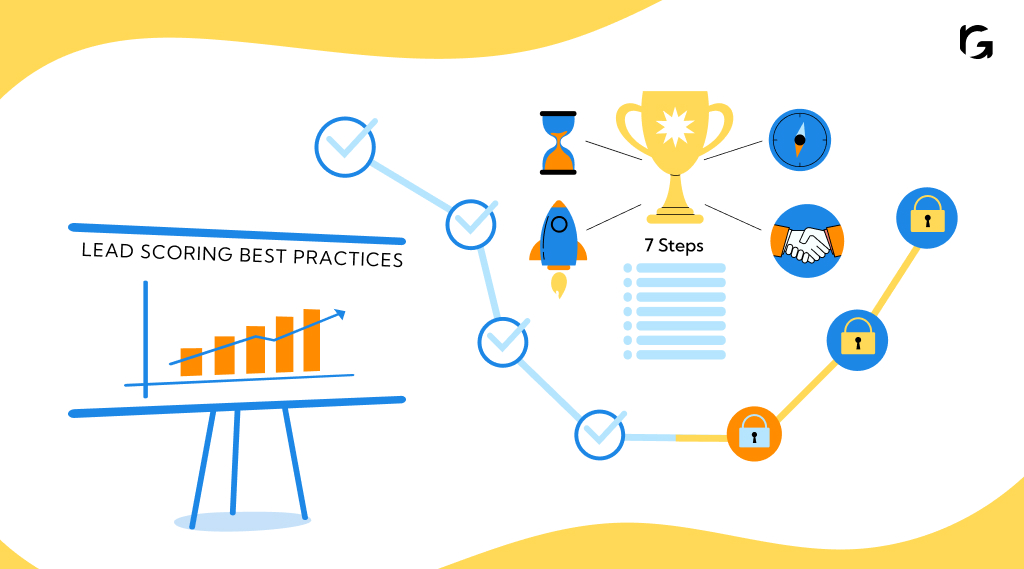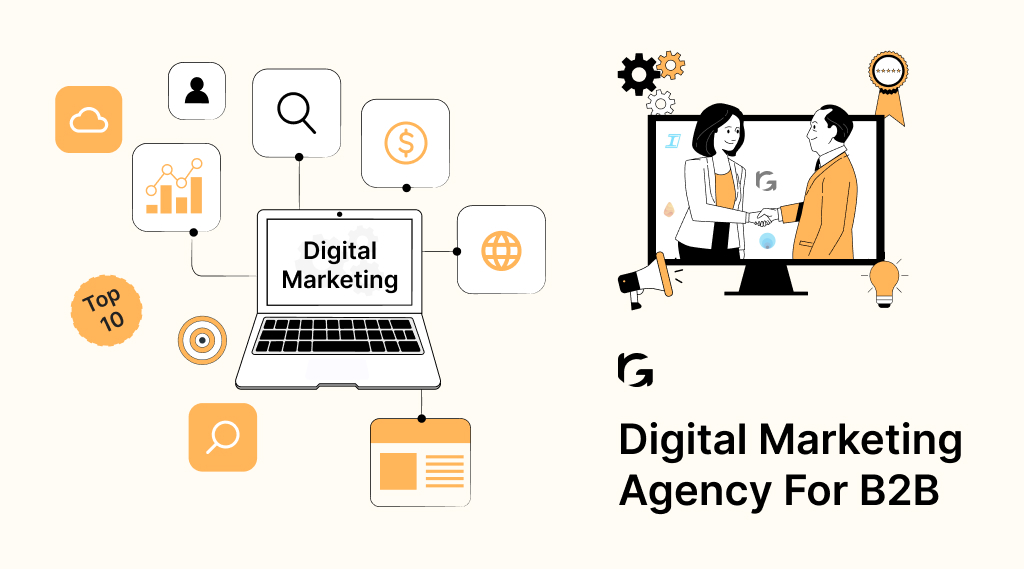Introduction
Lead scoring, a methodology that assigns numerical values to leads based on their characteristics and behavior, has emerged as a critical tool for businesses seeking to maximize the efficiency of their sales and marketing efforts. In this article, we’ll explore the seven lead scoring best practices tailored for the demands of 2024. From data analytics to sales and marketing teams, these practices are designed to help businesses adapt to the requirement of lead generation and conversion.
By embracing these best practices, businesses can not only streamline their lead management processes but also cultivate stronger relationships with prospects and drive sustainable growth in the years ahead.
Let’s delve into these strategies to discover how your business can stay ahead of the curve and win your leads in 2024.
What are the basics of lead scoring?
Lead scoring is a methodology used by sales and marketing teams to prioritize and qualify leads based on their likelihood to convert into customers. It involves assigning numerical values, or scores, to leads based on various criteria such as their behavior, demographics, interactions with your brand, and engagement level.
Lead scoring helps sales teams focus their efforts on leads that are most likely to result in conversions, thereby maximizing efficiency and improving overall sales performance.
Here are the basics of lead scoring:
1. Define lead qualification criteria
- The first step in lead scoring is to establish criteria that define what constitutes a qualified lead for your business. This can include factors such as job title, industry, company size, geographic location, and more.
- Additionally, consider behavioral indicators such as website visits, email interactions, content downloads, webinar attendance, social media engagement, and any other actions that demonstrate interest in your products or services.
2. Assign point values
- Once you’ve identified your lead qualification criteria, assign point values to each criterion based on its importance in determining lead quality.
- For example, a lead’s job title might be assigned 10 points if it matches your target audience, while a lead’s engagement with your website might be assigned 5 points for each page visit and 15 points for downloading a whitepaper.
3. Set thresholds
- Determine the threshold score that qualifies a lead as marketing-qualified (MQL) or sales-qualified (SQL). This threshold score will vary depending on your business goals, industry, and sales process.
- Leads that surpass the MQL threshold are considered marketing-qualified and are handed off to the sales team for further nurturing and follow-up. Leads that surpass the SQL threshold are considered sales-ready and are prioritized for immediate contact.
4. Implement scoring system
- Use marketing automation software or customer relationship management (CRM) systems to implement your lead scoring system.
- Track and record lead interactions across various channels to automatically calculate lead scores in real-time.
- Ensure that your scoring system is flexible enough to accommodate updates and changes as your business evolves.
5. Monitor and adjust
- Regularly monitor the effectiveness of your lead scoring model by analyzing conversion rates, sales velocity, and other key performance indicators.
- Adjust your scoring criteria and point values as needed based on feedback from sales teams, changes in market dynamics, or shifts in your ideal customer profile.
- Continuously refine and optimize your lead scoring system to ensure that it accurately reflects the characteristics of high-quality leads and aligns with your business objectives.
6. Align sales and marketing teams
- Promote collaboration and communication between sales and marketing teams to ensure that both departments are aligned on lead scoring criteria, thresholds, and processes.
- Regularly review lead scoring results together to identify areas for improvement and opportunities for better targeting and nurturing of leads.
By implementing a lead scoring system, businesses can streamline their sales and marketing efforts, prioritize resources effectively, and ultimately increase conversion rates and revenue.
7 Lead scoring best practices to improve lead quality
Here are seven lead scoring best practices to effectively win leads in 2024
- Continuous refinement
- Data-driven approach
- Multi-dimensional scoring
- Collaboration between sales and marketing
- Lead nurturing strategies
- Transparency and documentation
- Performance monitoring and optimization
Let us understand each of them in detail:
1. Continuous refinement:
- Dynamic adaptation: Regularly review and update your lead scoring model to reflect changes in market trends, customer behavior, and business objectives.
- Feedback loop: Gather input from both sales and marketing teams to identify areas for improvement and adjust scoring criteria accordingly.
2. Data-driven approach:
- Use data insights: Leverage data analytics and predictive modeling techniques to identify patterns and correlations that can enhance lead scoring accuracy.
- Incorporate AI and machine learning: Harness the power of artificial intelligence and machine learning algorithms to automate lead scoring processes and uncover predictive insights.
3. Multi-dimensional scoring
- Beyond demographics: Incorporate behavioral signals such as engagement with content, interaction with marketing campaigns, and responsiveness to sales outreach into your lead scoring criteria.
- Intent signals: Integrate signals of purchase intent, such as specific actions on your website, social media engagement, or attendance at industry events, to prioritize leads with a higher likelihood of conversion.
4. Collaboration between sales and marketing
- Alignment of goals: Promote collaboration and alignment between sales and marketing teams to ensure that lead scoring criteria reflect the collective understanding of ideal customer profiles and buying signals.
- Shared accountability: Establish shared accountability for lead generation and conversion goals, with both teams contributing insights and feedback to optimize the lead scoring process.
5. Lead nurturing strategies
- Segmentation for personalization: Segment leads based on their scores and tailor lead nurturing campaigns to address their specific needs and interests.
- Progressive profiling: Continuously gather additional information about leads over time through progressive profiling techniques, allowing for more refined lead scoring and personalized engagement.
6. Transparency and documentation
- Documented criteria: Clearly document the lead scoring criteria, thresholds, and processes to ensure transparency and alignment across the organization.
- Educate stakeholders: Provide training and resources to sales and marketing teams to ensure understanding of the lead scoring methodology and its implications for prioritizing leads.
7. Performance monitoring and optimization:
- KPI tracking: Monitor key performance indicators (KPIs) such as conversion rates, lead velocity, and sales cycle length to assess the effectiveness of your lead scoring model.
- A/B testing: Conduct A/B tests to experiment with different scoring parameters and validate the impact on lead conversion rates, allowing for continuous optimization of the lead scoring process.
By implementing these lead scoring best practices, businesses can enhance their ability to identify and prioritize high-quality leads, improve sales and marketing efficiency, and ultimately drive higher conversion rates and revenue growth in 2024 and beyond.
What are the criteria for scoring leads?
The criteria for scoring leads can vary depending on the nature of the business, target audience, industry, and specific goals. However, here are some common criteria used for scoring leads:
1. Demographic information
- Job Title/Role: Decision-makers or influencers within organizations are often considered higher-quality leads.
- Industry: Certain industries may be more aligned with the business’s offerings and therefore considered more valuable.
- Company Size: The size of the company can indicate its potential purchasing power and scalability of the deal.
2. Firmographic data
- Geographic Location: Leads from regions where the business operates or has a strong presence may be prioritized.
- Company Revenue: Larger companies with higher revenue may have more budget for purchasing products or services.
3. Behavioral data
- Website Visits: The frequency and duration of visits to the business’s website can indicate interest and engagement.
- Content Downloads: Leads who download gated content such as whitepapers, eBooks, or case studies are often more engaged and interested in learning more about the business’s offerings.
- Email Interactions: Opening emails, clicking on links, and responding to calls-to-action within emails can signal interest and engagement.
- Webinar Attendance: Participation in webinars or online events demonstrates active engagement with the business’s content and offerings.
- Social Media Engagement: Likes, shares, comments, and interactions on social media platforms can indicate interest and brand affinity.
4. Engagement level
- Lead Scoring allows businesses to assign points for various levels of engagement. For instance, a lead who attended a webinar might score higher than one who only downloaded a single piece of content.
- Multiple Interactions: Leads who engage with multiple touchpoints or channels may be considered more interested and qualified.
5. Purchase intent
- Specific Actions: Certain actions such as requesting a demo, signing up for a free trial, or inquiring about pricing indicate a higher level of intent to purchase.
- Timeframe: Leads who express urgency or indicate a shorter timeline for making a purchase decision may be scored higher.
It’s essential for businesses to continuously evaluate and refine their lead scoring criteria based on feedback from sales teams, performance metrics, and changes in the market landscape. By aligning lead scoring criteria with business objectives and target audience characteristics, businesses can effectively prioritize their resources and focus on leads with the highest potential for conversion.
Conclusion
From continuously refining scoring criteria to leveraging advanced data analytics and AI-driven insights, these best practices empower businesses to identify and prioritize leads with precision and efficiency.
Moreover, promoting collaboration between sales and marketing teams, adopting personalized lead nurturing strategies, and maintaining transparency in scoring processes are key ingredients for building strong customer relationships and driving long-term growth.
By prioritizing lead scoring excellence, businesses can not only stay ahead of the curve but also unlock new opportunities for innovation, differentiation, and sustainable success in the years ahead.
So remember that excellence in lead scoring isn’t just a strategy—it’s a mindset that drives enduring success in today’s dynamic business landscape.


